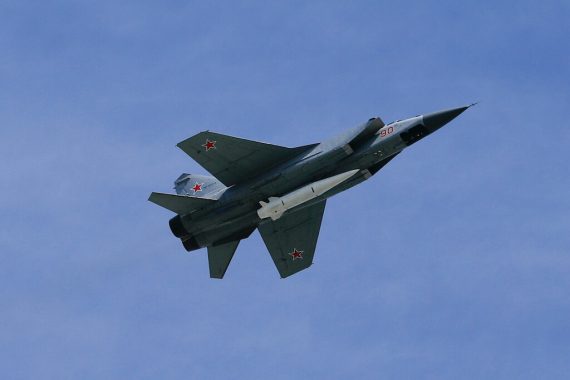Russian Strategic Missile Force Commander Colonel General Sergei Karakayev announced on June 5 that the second regiment of intercontinental ballistic missiles equipped with the Avangard hypersonic glide vehicles was preparing to go on combat alert. Karakayev stated that the first regiment is already on full alert and the second regiment is being prepared as per the “present-day realities.” Karakayev claimed that no anti-ballistic missile defense system is able to counter the Avangard hypersonic weapon system.
On May 31, the Russian Ministry of Defense announced that on May 28 the Project 22350 class Admiral Gorshkov frigate performed a test fire for the Tsirkon missile from the Barents Sea. According to a report by Russian TASS news agency, the missile hit a target 1,000 km from the warship. The test marked the completion of the state trials, therefore concluding the development process of the weapon system, which was designed for launch from naval vessels.
Earlier this year, for the first time, the Russian Air Force used the Kinzhal air-launched hypersonic missile against targets in Ukraine. The Russian Ministry of Defense announced that Kinzhals were fired from MiG-31K fighter aircraft on March 19 and 20 targeting an underground weapons storage in Ivano-Frankivsk and a fuel depot in Mykolaiv, respectively. These were the first instances of combat use of the Kinzhal hypersonic weapon system.
The Avangard, the Tsirkon, and the Kinzhal are three of the most advanced missile systems recently put into service by the Russian Federation. Categorized as “hypersonic missiles,” these weapon systems have become more prominent in the defense and security agenda. Their characteristics, most importantly their speed, make them strategic assets. The special emphasis on hypersonic weapons by the Russian political leadership and, consequently, the defense industrial base reflects Russia’s perception and assessment in the balance of power with its peer competitors.
Hypersonic flight
The speed of sound is one of the fundamental design parameters in aerospace engineering. The maximum and cruise speed of the air platform, whether or not it will fly faster than the speed of sound, profoundly affects the design characteristics. Based on the speed parameter, there are four main flight regime types of hypersonic missiles. These categories are determined according to Mach number, which is the ratio of the speed of the air platform to the speed of sound.
Flight at speed faster than that of sound is called supersonic, while speeds at least five times the speed of sound are called hypersonic. The design, development, and testing of aircraft flying at hypersonic speeds is one of the most advanced and complex issues in aerospace engineering.
The main advantage of hypersonic flight is the shortening of time required to reach the target. Several hypersonic passenger plane designs have been offered lately, promising dramatically short flight times over long distances. In terms of military aircraft, the hypersonic capability enables short reaction time and minimum time of exposure to enemy air defenses. But the main application area of hypersonic flight technology is long-range weapons.
There are three main types of weapon systems that fly at hypersonic speed: ballistic missiles, cruise missiles, and hypersonic glide vehicles (HGVs).
Ballistic missiles are projectiles that deliver a warhead and fly along a trajectory governed by aerodynamic effects. The missile is propelled, usually vertically with the help of the thrust achieved by the burning of liquid or solid fuel. After the burnout of the fuel, the missile flies along a ballistic trajectory, during a phase called “midcourse.” Modern ballistic missiles are equipped with trajectory correction systems that increase the missile’s precision. Depending on the design and performance characteristics, the missile achieves hypersonic speeds at the terminal phase before it hits its target.
Cruise missiles are weapon systems that perform level flight in a relatively straight line along their route, usually at very low altitudes to avoid detection. Cruise missiles are controlled by an autopilot that commands the maneuvers during flight. They are equipped with different types of sensors and guidance computers to achieve pinpoint accuracy. Until recently, cruise missiles of different countries were equipped with jet engines that enabled high subsonic or supersonic speeds.
With the introduction of new propulsion technologies such as scramjet and the turbine-based combined cycle (TBCC), hypersonic cruise missiles have become a reality. For comparison, the Tsirkon hypersonic missile is claimed to be able to strike a target at approximately 2,500 km range in 20 to 30 minutes, whereas a Tomahawk missile, which has a maximum speed of around 885 km/hours, can fly the same distance in about 3 hours.
Hypersonic glide vehicles (HGVs) are air vehicles that glide towards the target at high hypersonic speeds, as high as Mach 20. HGVs, in essence, are not different from traditional ballistic missiles, which are launched usually vertically, and upon expending fuel, carry the warhead along a ballistic trajectory to the target.
Similar to the operating principle of a ballistic missile, in which the warhead section is carried towards the target with single or multiple stages, HGVs are carried to the upper layers of the atmosphere, mostly with an intercontinental ballistic missile (ICBM). However, unlike ballistic missiles, the warhead is released at comparatively lower altitudes. Once released, the HGV flies along its route using the speed gained until that moment and executes maneuvers using control surfaces and thrusters.
The main advantage of HGVs over ballistic missiles lies in the capability to execute maneuvers, making it almost impossible to predict the impact point and therefore the target. Combined with the excessively high speed, HGVs become virtually immune to anti-ballistic missile defense systems, early warning, and tracking systems.
Russian hypersonic weapon systems
The Soviet Union started working on a hypersonic platform in the mid-1980s. After the economic recovery in the early 2000s, and the emphasis on modernization of strike capabilities, Russia started multiple projects to develop several types of tactical and strategic weapon systems, hypersonic missiles having top priority.
On March 1, 2018, Russian President Vladimir Putin unveiled several strategic weapon systems during a televised address to the country’s political elite. Videos and computer graphics showed the operation and characteristics of several advanced weapon systems such as ICBMs, nuclear-powered cruise missiles, nuclear-armed underwater drones, and hypersonic missiles. The speech was widely perceived as a milestone in the new arms race during the heightened tensions between the West and Russia after the annexation of Crimea by the latter.
Among the weapon systems presented by Putin, two hypersonic weapon systems made the headlines in Western defense and intelligence circles: the Kinzhal and the Avangard.
The Kinzhal
The Kh-47M2 Kinzhal is an aircraft-launched derivative of the 9M723 tactical ballistic missile, which is used with the Iskander M system. The missile can be fired from the MiG-31K, which is a specially modified version of the MiG-31BM, which itself is the upgraded version of the MiG-31 (NATO code “Foxhound”) interceptor. The Tu-22M3M, a modernized version of the Tu-22M3 (NATO code “Backfire”) bomber, can also fire the Kinzhal.
Initial reports about an air-launched version of the Iskander missile first surfaced as early as the mid-2010s. The first fire tests took place in 2017, followed by a ship-launched test in January 2020 during an exercise of the Black Sea Fleet. In June 2021, Kinzhal-equipped MiG-31K fighters were seen at the Hmeimim Air Base in Syria, while participating in exercises in the Eastern Mediterranean. Kinzhal-equipped MiG-31Ks were also deployed to Kaliningrad this February, shortly before the start of the Russian invasion of Ukraine.
Russian sources claim Kinzhal has a range of more than 2,200 km when fired from the MiG-31K and more than 3,000 km when fired from the Tu-22M3M. The missile is capable of carrying a maximum of 480 kg conventional or nuclear warheads with an overall weight of 4,300 kg. After launch, the missile flies Mach 4 and is claimed to achieve speeds as fast as Mach 10. The Kinzhal is also reported to have maneuvering capability to disrupt enemy air defenses, but it is unclear how it performs this.
Recommended
The Avangard
The Avangard, which was previously known as “Object 4202,” is an HGV that is carried by the UR-100NUTTKh (NATO code SS-19 Mod 3 “Stiletto”), RS-26 Rubezh, or RS-28 Sarmat (NATO code “SS-X-29”) ICBMs. The Avangard has a reported range of around 6,000 km with an overall weight of 2,000 kg. It can be equipped with a conventional or nuclear warhead.
The origins of the Avangard date back to the 1980s, when the Soviet Union started to work on hypersonic weapon systems. After a pause caused by the dissolution of the Soviet Union, the program resumed in the mid-1990s under the codename “Project 4202.” The flight test period took place between 1990 and 2018, followed by the first live fire in December 2018.
The 3M22 Tsirkon
The Tsirkon is a scramjet-powered hypersonic cruise missile, being developed primarily as an anti-ship weapon system.
The project was first unveiled during the MAKS air show in 1995. First firing took place from a Tu-22M3 bomber in 2012, followed by ground launch tests in 2015. During a test in April 2017, the Tsirkon achieved Mach 8 speed. In November 2017, Russian Air Force Commander Viktor Bondarev announced that the weapon was in service. During a speech in February 2019, Putin claimed that the Tsirkon can fly as fast as Mach 9 and has a range of approximately 1,000 km.
Read: F-16Vs Instead of F-35s?
Between 2020 and 2022, a number of fire tests were completed from the Project 22350 class Admiral Gorshkov frigate in the White Sea. In 2021, the first submarine launch was successfully completed from Project 885 class Severodvinsk nuclear attack submarine.
Project 1144 Kirov class Admiral Nakhimov cruiser, Project 11356R Admiral Grigorovich, and Project 22350 Admiral Gorshkov class frigates will reportedly be equipped with the Tsirkon.
What’s next?
Russia has been diverting and allocating significant resources for improving its long-range precision strike capabilities, and hypersonic weapon systems have been at the top of this list. The United States’ withdrawal from the Anti-Ballistic Missile Treaty (ABM Treaty or ABMT) and the recent mutual withdrawal from the Intermediate-Range Nuclear Forces (INF) Treaty have been important milestones in Russia’s perception and assessment of strategic competition and balance of power. The U.S. ballistic missile shield program and the installation of early warning sites in Eastern Europe, as well as the development of the Standard Missile 6 (SM-6) were seen by Moscow as major threats to nuclear deterrence.
Due to their short reaction time, precision, and capability to inflict high damage, hypersonic weapon systems have become critical assets for Russia. The use of hypersonic weapons can be compared to a gun duel, where the shooter who draws the gun fastest can shoot the opponent first and win. Statements by Russian officials, starting from President Putin himself, confirm that Russia assesses hypersonic weapons as the preferred “gun” in a potential duel with the United States.





